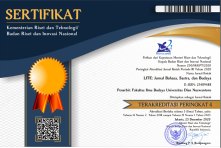“Jangan Di-Read!”: Indonesian Affixation to English Words on Social Media
Abstract
Keywords
References
Budiarti, D. (2022). Variasi Penggunaan Strategi Kesantunan sebagai Penanda Subordinasi Mahasiswa dalam Interaksi Lisan Tertulis. Diglosia: Jurnal Kajian Bahasa, Sastra, dan Pengajarannya, 5(4), 859–872. https://doi.org/10.30872/diglosia.v5i4.527
Chaer, A. (2003). Psikolinguistik: Kajian Teoretik. Rineka Cipta.
Hakim, A. (2008). Afiksasi pada Kosakata Asing dalam Majalah Teknologi Informasi PC Media. Indonesia University.
Hockett, C. (1958). A Course in Modern Linguistics. The Macmillan Company.
Holmes, J. (2001). An Introduction to Sociolinguistics. Longman.
Keller, E., & Berry, J. (2003). The Influentials. The Free Press.
Khotimah, K. (2012). Analysis of Indonesian Affixes in English Words Found in Mobile Guide Edition: 54-59 . Diponegoro University.
Kridalaksana, H. (1996). Pembentukan Kata dalam Bahasa Indonesia. Gramedia Pustaka Utama.
Kridalaksana, H. (2007). Bahasa dan Linguistik. Gramedia Pustaka Utama.
Kusuma, D. S. (2014). Indonesian Affixation Attached to English Words in Poconggg Juga Pocong . Indonesia University of Education.
Paramarta, I. M. S. (2022). Word formation in social media communication of the students of English Department. Uniqbu Journal of Social Sciences, 3(1), 84–98.
Ramlan, M. (1992). Introduction to Linguisic Analysis. IKIP Semarang Press.
Ramlan, M. (2001). Sintaksis Ilmu Bahasa Indonesia. Karyono.
S. Esteron, M. A. (2021). Different Language Usage on Social Media. International Journal of Advanced Engineering, Management and Science, 7(3), 093–104. https://doi.org/ 10.22161/ijaems.73.12
Sudaryanto. (1993). Metode dan Aneka Teknik Analisis Bahasa Pengantar Penelitian Wahana Kebudayaan secara Linguistics. Duta Wahana University Press.
Suswandi, I. (2022). Analysis of affix -ly as modifier of adverb of manner in social media posts. Jurnal Kata: Penelitian Tentang Ilmu Bahasa Dan Sastra, 6(2), 358–368.
Sutrismi. (2014). The Use of Indonesian English Code Mixing in Social Media Networking (Facebook) by Indonesian Youngsters. Universitas Muhammadiyah Surakarta.
Suwito. (1996). Alih Kode, Campur Kode, Interferensi. Binary Offset.
Zhao, D., & Rosson, M. B. (2009). How and why people Twitter. Proceedings of the 2009 ACM International Conference on Supporting Group Work, 243–252. https://doi.org/10.1145/ 1531674.1531710
DOI: https://doi.org/10.33633/lite.v19i1.7492
Article Metrics
Abstract view : 176 timesPDF - 93 times Similarity Check - 54 times
Refbacks
- There are currently no refbacks.
Copyright (c) 2023 Dian Budiarti, Ihsan Nur Iman Faris
ISSN Online: 2548-9588
This work is licensed under a Creative Commons Attribution-ShareAlike 4.0 International License.
This journal is published by Universitas Dian Nuswantoro, Semarang, Indonesia.
Indexing & Archiving:
IN COLLABORATION WITH:
Indonesian Pragmatics Association
Konsorsium Program Studi Jepang Indonesia
Center for Foreign Language Training
Asosiasi Studi Pendidikan Bahasa Jepang Indonesia







































